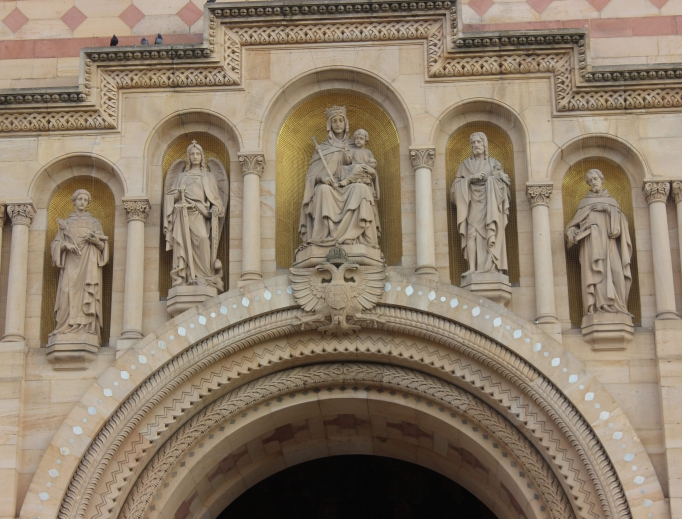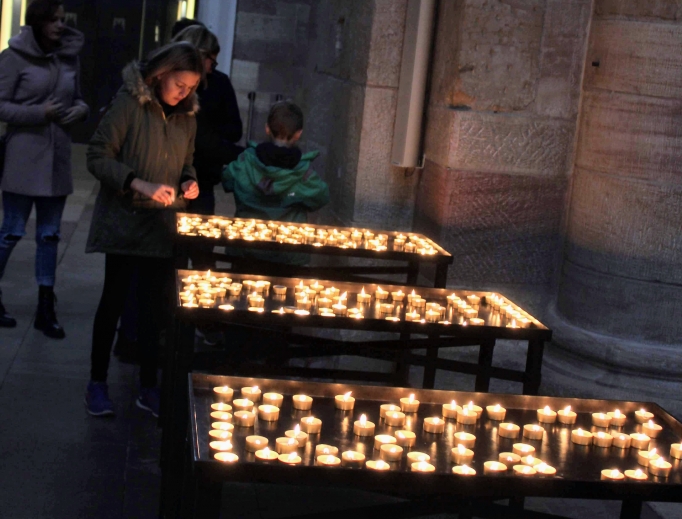Honoring Mary: The Speyer Cathedral’s Marian Legacy
Impressive scenes of the Blessed Virgin Mary’s life are present

Germany’s Speyer Cathedral is officially known as the imperial Cathedral-Basilica of the Assumption and St. Stephen, because the cathedral is dedicated to St. Mary, patron saint of Speyer (Patrona Spirensis), and to St. Stephen.
From the arched doors and windows to the architectural artistry of the matching light-red and tan bricks, it is an exceptional sight. It even escaped damage during World War II. This Marian cathedral is a beacon of Romanesque architecture in the 21st century.
Impressive scenes of the Blessed Virgin Mary’s life are present on both sides of the cathedral, also known as the Mariendom. A large statue of Mary is positioned next to the high altar. In the St. Afra Chapel, at the end of the cathedral’s left side aisle, is a depiction of the Annunciation to the Blessed Virgin Mary by the angel Gabriel.


The church, as my husband Kent and I discovered via a guided tour and accompanying historical information, had begun in 1030 under Konrad II and is laid out in the form of a cross — the choir represents Christ’s head while the transept and nave are representative of his body. The light flows through his head to animate his body. The narthex can be entered from three different doors. Five figures have been placed above the central façade, representing St. Stephen, Michael the Archangel, Mary, St. John the Baptist and St. Bernard of Clairvaux. St. Bernard was a renowned visitor to the cathedral in the Middle Ages, circa 1146. Upon entering, visitors come upon the massive statues of those buried in the cathedral.
The main part of the cathedral (or nave) is accessible through only one massive 1,000-year-old metal door that will only admit one person at a time. (One must hold open this very heavy door that is trying to close, so quickness is needed.) This sole portal is meant to signify the narrow gate to heaven.
The immensely high vaulted ceiling dwarfs any human. The interior is dark, lit only from sun rays coming through the stained-glass windows.
Because it is rather dark and dreary, the perfect time of day for a visit is when beams of sunlight hit the frescoes on the wall, highlighting their beauty. The main altar is simple. It, too, is touched by sun coming through the stained glass. As a painter, I have always seen sunlight as a way to highlight beauty.
The crypt, which was dedicated in 1041, is the oldest component of the cathedral. In an excavation in 1900, graves were opened, and the identity of the rulers was established: eight German emperors and kings, three empresses and a number of bishops.
The gravesites, which originally lay in the nave, were relocated to the crypt in the course of renovation undertaken between 1900 and 1906. The crypt is of special interest since it has retained its original condition. One of the highlights of the crypt is the baptismal font made from one large stone.
During our visit, a group of schoolchildren were inspecting the “Cathedral Bowl” in front of the church. Since its construction in the 14th century, this wine bowl has played a significant role in the non-execution of a prison sentence. Whoever had broken a state law and fled to the Cathedral Bowl was protected from prosecution. It has been a long time since the Cathedral Bowl has fulfilled this historical function. But another beloved medieval custom continues to be observed in modern times. On special religious occasions, the 1,500-liter bowl is filled with wine and offered to worshippers; most recently, at the 950-year anniversary of the dedication of the cathedral on Oct. 2, 2011.
Pope Pius XI raised Speyer Cathedral to the rank of a minor basilica in 1925. In 1981, the cathedral was added to the UNESCO “World Heritage List” of culturally important sites as “a major monument of Romanesque art in the German Empire.”
Wynne Crombie writes
from Huntley, Illinois.
IF YOU GO
Address and phone: Edith-Stein-Platz 67346 Speyer, Germany; +49 6232 102118
Website: Dom-zu-speyer.de/en/
- Keywords:
- marian devotion
- travel

















